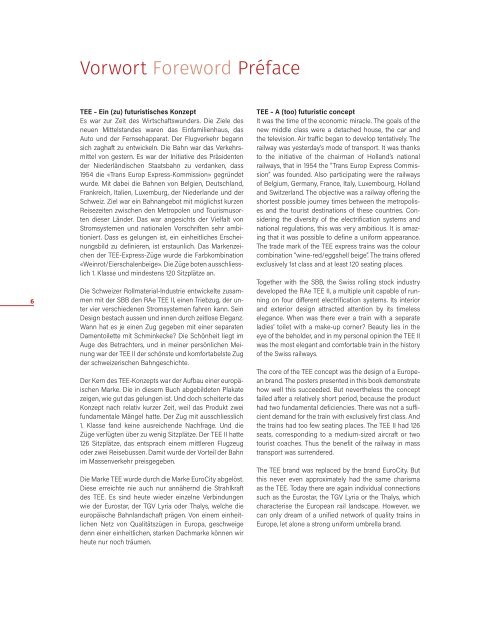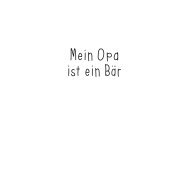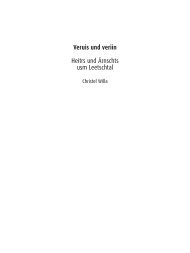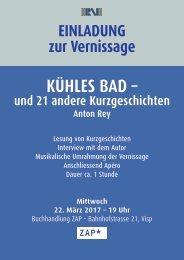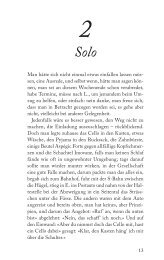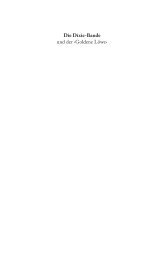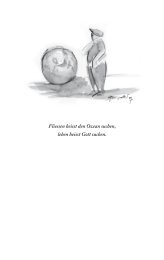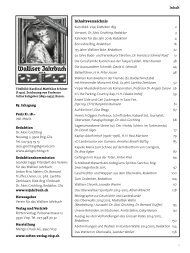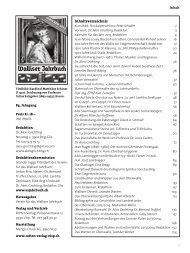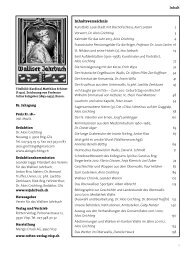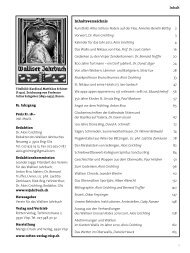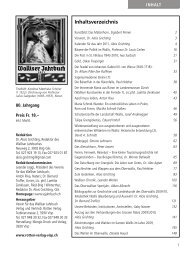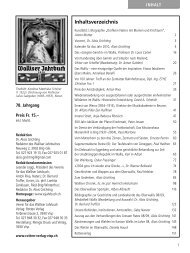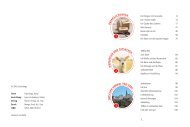TEE-Plakate_Leseprobe
Create successful ePaper yourself
Turn your PDF publications into a flip-book with our unique Google optimized e-Paper software.
Vorwort Foreword Préface<br />
6<br />
<strong>TEE</strong> – Ein (zu) futuristisches Konzept<br />
Es war zur Zeit des Wirtschaftswunders. Die Ziele des<br />
neuen Mittelstandes waren das Einfamilienhaus, das<br />
Auto und der Fernsehapparat. Der Flugverkehr begann<br />
sich zaghaft zu entwickeln. Die Bahn war das Verkehrsmittel<br />
von gestern. Es war der Initiative des Präsidenten<br />
der Niederländischen Staatsbahn zu verdanken, dass<br />
1954 die «Trans Europ Express-Kommission» gegründet<br />
wurde. Mit dabei die Bahnen von Belgien, Deutschland,<br />
Frankreich, Italien, Luxemburg, der Niederlande und der<br />
Schweiz. Ziel war ein Bahnangebot mit möglichst kurzen<br />
Reisezeiten zwischen den Metropolen und Tourismusorten<br />
dieser Länder. Das war angesichts der Vielfalt von<br />
Stromsystemen und nationalen Vorschriften sehr ambitioniert.<br />
Dass es gelungen ist, ein einheitliches Erscheinungsbild<br />
zu definieren, ist erstaunlich. Das Markenzeichen<br />
der <strong>TEE</strong>-Express-Züge wurde die Farbkombination<br />
«Weinrot/Eierschalenbeige». Die Züge boten ausschliesslich<br />
1. Klasse und mindestens 120 Sitzplätze an.<br />
Die Schweizer Rollmaterial-Industrie entwickelte zusammen<br />
mit der SBB den RAe <strong>TEE</strong> II, einen Triebzug, der unter<br />
vier verschiedenen Stromsystemen fahren kann. Sein<br />
Design bestach aussen und innen durch zeitlose Eleganz.<br />
Wann hat es je einen Zug gegeben mit einer separaten<br />
Damentoilette mit Schminkecke? Die Schönheit liegt im<br />
Auge des Betrachters, und in meiner persönlichen Meinung<br />
war der <strong>TEE</strong> II der schönste und komfortabelste Zug<br />
der schweizerischen Bahngeschichte.<br />
Der Kern des <strong>TEE</strong>-Konzepts war der Aufbau einer europäischen<br />
Marke. Die in diesem Buch abgebildeten <strong>Plakate</strong><br />
zeigen, wie gut das gelungen ist. Und doch scheiterte das<br />
Konzept nach relativ kurzer Zeit, weil das Produkt zwei<br />
fundamentale Mängel hatte. Der Zug mit ausschliesslich<br />
1. Klasse fand keine ausreichende Nachfrage. Und die<br />
Züge verfügten über zu wenig Sitzplätze. Der <strong>TEE</strong> II hatte<br />
126 Sitzplätze, das entsprach einem mittleren Flugzeug<br />
oder zwei Reisebussen. Damit wurde der Vorteil der Bahn<br />
im Massenverkehr preisgegeben.<br />
Die Marke <strong>TEE</strong> wurde durch die Marke EuroCity abgelöst.<br />
Diese erreichte nie auch nur annähernd die Strahlkraft<br />
des <strong>TEE</strong>. Es sind heute wieder einzelne Verbindungen<br />
wie der Eurostar, der TGV Lyria oder Thalys, welche die<br />
europäische Bahnlandschaft prägen. Von einem einheitlichen<br />
Netz von Qualitätszügen in Europa, geschweige<br />
denn einer einheitlichen, starken Dachmarke können wir<br />
heute nur noch träumen.<br />
<strong>TEE</strong> – A (too) futuristic concept<br />
It was the time of the economic miracle. The goals of the<br />
new middle class were a detached house, the car and<br />
the television. Air traffic began to develop tentatively. The<br />
railway was yesterday’s mode of transport. It was thanks<br />
to the initiative of the chairman of Holland’s national<br />
railways, that in 1954 the “Trans Europ Express Commission”<br />
was founded. Also participating were the railways<br />
of Belgium, Germany, France, Italy, Luxembourg, Holland<br />
and Switzerland. The objective was a railway offering the<br />
shortest possible journey times between the metropolises<br />
and the tourist destinations of these countries. Considering<br />
the diversity of the electrification systems and<br />
national regulations, this was very ambitious. It is amazing<br />
that it was possible to define a uniform appearance.<br />
The trade mark of the <strong>TEE</strong> express trains was the colour<br />
combination “wine-red/eggshell beige”. The trains offered<br />
exclusively 1st class and at least 120 seating places.<br />
Together with the SBB, the Swiss rolling stock industry<br />
developed the RAe <strong>TEE</strong> II, a multiple unit capable of running<br />
on four different electrification systems. Its interior<br />
and exterior design attracted attention by its timeless<br />
elegance. When was there ever a train with a separate<br />
ladies’ toilet with a make-up corner? Beauty lies in the<br />
eye of the beholder, and in my personal opinion the <strong>TEE</strong> II<br />
was the most elegant and comfortable train in the history<br />
of the Swiss railways.<br />
The core of the <strong>TEE</strong> concept was the design of a European<br />
brand. The posters presented in this book demonstrate<br />
how well this succeeded. But nevertheless the concept<br />
failed after a relatively short period, because the product<br />
had two fundamental deficiencies. There was not a sufficient<br />
demand for the train with exclusively first class. And<br />
the trains had too few seating places. The <strong>TEE</strong> II had 126<br />
seats, corresponding to a medium-sized aircraft or two<br />
tourist coaches. Thus the benefit of the railway in mass<br />
transport was surrendered.<br />
The <strong>TEE</strong> brand was replaced by the brand EuroCity. But<br />
this never even approximately had the same charisma<br />
as the <strong>TEE</strong>. Today there are again individual connections<br />
such as the Eurostar, the TGV Lyria or the Thalys, which<br />
characterise the European rail landscape. However, we<br />
can only dream of a unified network of quality trains in<br />
Europe, let alone a strong uniform umbrella brand.


